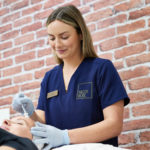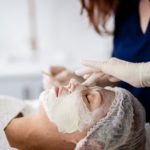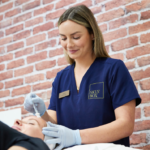By M.A. Glaskin – Dermal Therapist
Washing your face is important. It’s a fundamental part of a skincare regimen and most of us are well versed in the benefits.
Dr. Josh Zeichner a New York board-certified dermatologist and Director of Cosmetic & Clinical Research in Dermatology, explains that “the goal of cleansing is to remove dirt, oil, makeup, and other impurities without compromising the integrity of the skins outer layer.
Using the wrong cleanser can interfere with optimal skin functioning and opting for a cleanser that’s too strong can overly strip the skin, causing dryness and irritation.
Josh Zeichner MD
Another lesser-known benefit of cleansing properly: having a clean canvas also means you get the best out of your cosmeceutical products.
Step one isn’t “wash your face”, it’s actually: choose your cleanser – carefully.
Choosing Your Cleanser
There are so many facial cleansers on the market. Gel, foam, oil, exfoliant, micellar and more… It can be hard to know which ones are worth the money and will work for you.
But first, here’s your go-to tips for navigating the world of cleansers:
- Cleansers are not a one-size-fits-all situation.
- Avoid cleansers and exfoliants with synthetic microbead technology.
- Steer clear of bars made of actual soap.
- Don’t get caught up on the fad cleansers or skin “rituals”.
- Choose a cleanser that is suited to your skin type and lifestyle.
- Avoid soaps and cleansers with harsh ingredients such as artificial fragrance and sulphates.
Oil Cleansers
The idea of using an oil to cleanse your skin at the end of the day feels counterintuitive but in fact, oil cleansers work on the principle of oil attracting oil.
Solvents are ingredients that dissolve similar substances. Makeup and sebum (the oily, waxy substance produced by your skin which can cause breakouts if a build-up occurs) are both oil-based which allows for oil cleansers to work their magic!
Oil cleansers act as a solvent and when massaged into your skin, they work by breaking down and dissolving makeup whilst lifting impurities, dirt, and sebum without stripping your skin’s microbiome.
The skin microbiome is the delicate balance of naturally occurring bacteria that lives on your skin and is meant to stay there! Oil cleansing balances the microbiome, which can also help keep acne at bay.
Other benefits include:
- Oil-based cleansers are gentle, and they leave that natural oil layer on top of the skin.
- They cause minimal irritation and are ideal for sensitive, acne and rosacea-prone skin.
However, not all oil cleansers are created equal. Poor quality products can clog pores, cause breakouts and even milia, so it is important to invest in a high-quality, formulated facial oil cleanser.
M.A’s go-to oil cleanser:
Universkin nexultra™ O Cleanser.
This is a multi-purpose oil facial cleanser: the formula is a patented combination of biomimetic peptides, olive oil, plant CO2 extracts and Omega-3, which aids in repairing the skin as well as cleansing the skin. This oil formula transforms into a milky emulsion when combined with water that gently rinses away to promote a supple, hydrated complexion.
It is suitable for all skin types, including sensitive and acne-prone skin and safe for everyday use. No irritating pulling effect, only a soothed and fresh face after washing.
Water-Based Cleansers
These are among the most frequently purchased cleanser products on the market. How do they work?
The natural pH of the skin is around 5.5, so the optimal pH for a water-based cleanser should also be around this level (mildly acidic). This is to ensure our acid mantle is maintained and the crucial components of the skin’s barrier function and microbiome are not disrupted.
Water-based cleansers (foaming and non-foaming) and gels contain surfactants that work by drawing oil and water together such as dirt and impurities which emulsify in the lather of the surfactant (cleanser) and are then easily removed by rinsing away the particles from the skin’s surface.
Unfortunately, this can also remove natural oils, dehydrating the skin.
As a result, water-based cleansers are typically more suitable for oily or acne prone skin types. While water-based cleansers are popular, there are other products on the market that can be a better option, especially for people with sensitive or aging skin.
M.A.’s go-to water-based cleanser:
Synergie Skin’s UltraCleanse is a cleansing gel concentrate which is ideal for virtually every skin type including normal, combination and acne prone skin.
Physical Exfoliating Cleansers
Exfoliation is a necessary component of all skincare regimens. Physical exfoliants are a great way to manually exfoliate the skin provided the particles are non-irritating and are suited to your skin type.
Physical exfoliants can be used once a week or every other week to effectively remove dead cells, reduce the appearance of blackheads, maintain skin tone, and speed up the cell renewal process.
M.A.’s go-to physical exfoliating cleanser:
Synergie Skin’s MediScrub , which contains corundum crystals, is a good choice for most skin types. Corundum is almost identical to sapphire, one of the hardest known mineral materials, and the crystals are ideal for exfoliating the top layer of facial skin to remove dead cells and unblock pores, without scratching your skin or removing heathy skin cells.
Creating unwanted abrasions can accelerate the aging process and potentially cause scarring. We love corundum crystals because they are non-toxic and are environmentally sound.
Say “no” to microbead scrubs! These contain small bits of plastic that end up in the ocean and are toxic to marine life.
Chemical Exfoliating Cleanser
Chemical exfoliants are acids that react with the skin, gently loosening and removing built-up layers of dead cells from the surface of the skin and sebum that can cause breakouts and dull skin, without affecting the live skin layers beneath.
There are many types of chemical exfoliating cleansers on the market that incorporate acids including: AHA, BHA, Salicylic, lactic, glycolic and mandelic. According to Cosmetic Chemist and Founder of Synergie Skin, Terri Vinson explains that “most cleansers are only in contact with the face for an average of 20 seconds and then rinsed off, adding active ingredients in cleansers, such as AHA and BHA exfoliants is unnecessary as there is very little time for these active ingredients to work on the deeper layers of the skin if they are washed off in a few seconds.”
Acids have all different cellular compositions. The larger molecules focus on the outer layers of skin whilst the much finer molecules can reach the dermis for a more thorough exfoliation, therefore, if actives are added to a cleanser, they must be rapidly penetrating.
It makes sense that you are likely to gain greater benefit from a chemical exfoliant in a leave-on serum than in a cleanser.
This is where choosing the correct ingredients for your skin gets complicated and professional advice from a qualified Dermal Therapist can really save time, money and set you up for success.
Before considering a physical or chemical exfoliant cleanser, you should ensure it is suitable for your skin health. A quick checklist:
• Barrier function is not impaired.
• Skin is not broken or damaged.
• Have no active acne.
• Have no active psoriasis or eczema.
Follow the 60 second rule: Using gentle pressure, make small circles with your fingers for 60 seconds. This allows the ingredients in your cleanser to work their magic.
Important tip: over exfoliating will strip your skin of natural oils, leaving your face dry, sensitive or possibly even oilier as your skin starts over-produce oil to compensate. But on the flipside, not cleansing your face thoroughly enough can allow for dirt and acne causing bacteria to build up in your pores.
It’s a delicate balance. The Dermal Therapist team at SkinBox can walk you through your options at the Skin Bar; or access a personalised skin assessment online in only 10-minutes using our AI technology
References
Vinson,T (2021). Synergie Skin. Clean Science, Terri’s Blog. The role of prebiotics, probiotics, postbiotics in skincare. Retrieved 08 March 2022, from: https://synergieskin.com/terris-blog/the-role-of-prebiotics-probiotics-postbiotics-in-skincare/
Pai, D. A pH-Balanced Cleanser Might Give You Better Skin. Glamour. Zeichner, J MD. (May 2017). Retrieved 08 March 2022, from: https://www.glamour.com/story/why-ph-balancing-cleansers-better-skin
Zeichner, J Dr. (2022). From medical to cosmetic issues, we are here to address your skin’s needs. Retrieved 10 March 2022, http://www.zeichnerdermatology.com
Data Bridge Market Research, (Jan 2022). Global Facial Cleanser Market – Industry Trends and Forecast to 2029. Market Analysis and Insights of Facial Cleanser Market. Retrieved 07 March 2022, from: https://www.databridgemarketresearch.com/reports/global-facial-cleanser-market


